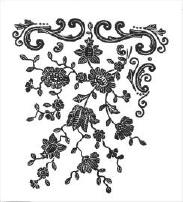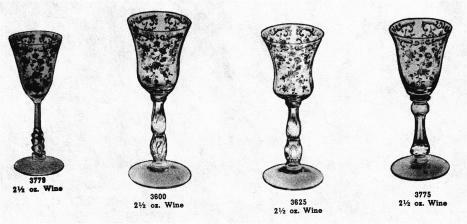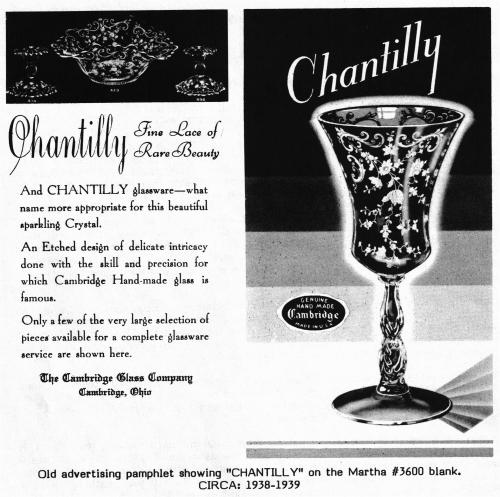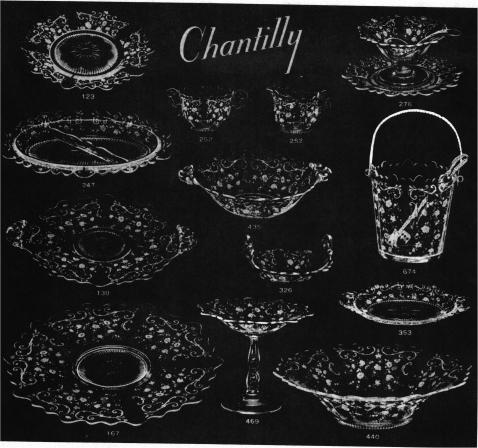Chantilly
by Mark Nye
Issue No. 151 - November 1985
"THE DISTINCTIVE CHANTILLY, A DESIGN OF EXCEPTIONAL DELICACY AND REFINEMENT"
The above is how Cambridge was continuing to introduce Chantilly to the buying public in the fall of 1939. To continue the above, taken from the October 1939 issue of House and Garden magazine, "Both Chantilly and Blossom Time are exceptionally light in weight and appearance, and harmonize perfectly with any type of decoration. Available in over 150 pieces at unusually modest prices."
 Exactly when Chantilly was first shown is not known, but it was
probably during early 1939 and almost certainly not before the fall of
1938. As always, the word "new," when found in Cambridge advertising,
is not to be taken literally every time it appears. For example,
Chantilly was being labeled "new" in July 1940, months after the above
advertisement was published and the etching appeared in the January
1940 catalog.
Exactly when Chantilly was first shown is not known, but it was
probably during early 1939 and almost certainly not before the fall of
1938. As always, the word "new," when found in Cambridge advertising,
is not to be taken literally every time it appears. For example,
Chantilly was being labeled "new" in July 1940, months after the above
advertisement was published and the etching appeared in the January
1940 catalog.
Chantilly proved to be a popular etching and thus became a major line for Cambridge. Over its almost twenty years of original availability, five different stemware lines were decorated with Chantilly and there were, at consecutive times, two different dinnerware lines. In addition, there was also a wide selection of decorative and accessory pieces offered with the Chantilly etching.
There is evidence to indicate Chantilly was being etched on two
stemware lines, #3600 and #3625, very early in 1939.
 By June of that
year it is known the #3600 line was being offered to the trade etched
Chantilly with a gold edge D/1060; and etched Chantilly, gold
encrusted, known as D/1061.
By June of that
year it is known the #3600 line was being offered to the trade etched
Chantilly with a gold edge D/1060; and etched Chantilly, gold
encrusted, known as D/1061.
It may have been around this same time, or perhaps not until 1940-41, that Chantilly was etched onto a seldom seen line of Cambridge stemware, #3138. This #3138 stemline, which has a molded "lady leg stem," is also known with two rock crystal cuttings. It's only known Cambridge catalog appearance is in a Rock Crystal catalog issued in May 1940.
The #3138/Chantilly combination has not been found in any Cambridge documents or advertising and is known only through the existence of actual examples that have been found during the past two years. It was apparently a short-lived stem line, cut or etched, since little is found today.
Recent research has produced evidence that it was probably sometime in 1942 that Chantilly was first used on #3775 stemware and not a year earlier as first believed. At the present time, however, neither date can be confirmed or ruled out.
The last line of stemware to be introduced with the Chantilly etching was #3779 and this combination was brought out sometime between June 1949 and September 1950. It, along with the #3600, #3625 and #3775 stemware, remained available etched Chantilly until the initial plant closing in the summer of 1954. During the reopen period, only stemware from the #3600 and #3625 line was available from open stock with the Chantilly etching. Through the Special Order service, available at least during 1956, replacement pieces for the #3775 and #3779 lines was made available.
In addition to the five complete lines of stemware, Chantilly will also be found on the #7801 12 oz. footed ice tea; the #7801 5 oz. footed tumbler; the #7911 cocktail (commonly called a #7801 cocktail) and the #7966 2 oz. sherry. Both of the true #7801 items were decorated with D/1060 and D/1061 during the late 1930s and early 1940s. (Ref: NCC 1930-34 Catalog Reprint, pages 33-B-7 and 34-4 for shape of these #7801, #7911 and #7866 stemware lines.)
During its years in the Cambridge line, Chantilly was, as mentioned earlier, used on two major lines - Martha (#3600) and Corinth (#3900). (Conclusive proof that the Martha line had the numerical designation #3600 was acquired when molds for Martha items were found with the number 3600 stamped into them.)
Martha was the first of the two lines to be used for this etching, and there was a full dinnerware line as well as accessory, serving and decorative items. It is highly likely, but unproven that the Martha line was introduced concurrently with Chantilly in late 1938 or early 1939. Following this line, which was for the most part discontinued during the late 1940s, Corinth became the blank of choice to receive the Chantilly etching. The first catalog to show the Corinth line is the one issued in June 1949 and again, there is a full line of dinnerware, serving, accessory and decorative items. Both the Martha and Corinth lines included a 10½" service or dinner plate, in addition to the regular 9½" dinner plate.
Apart from the two major lines, selected blanks from several other well-known Cambridge lines were used in conjunction with Chantilly. These were #3400, Gadroon and Pristine, in order as to the relative number of items etched Chantilly. Items from the #3400 line with Chantilly were mainly jugs, decanters and tumblers. Pieces used from the other two lines consisted mainly of bonbons, bowls and relishes.
Among the items to be found etched Chantilly are eight jugs or pitchers. From the first years of the pattern we have the #1561, #119, #3400/38 Ball jug and the #3400/152 Doulton pitcher. During the 1950s these were replaced with the four pitchers from the Corinth line, #115, #116, #117 and #118. Probably the most spectacular single piece to be found etched Chantilly is the Martha line ten-quart punch bowl. Complementary to this punch bowl is the Martha #129 18" tray or under plate and the #488 5 oz. punch cup. Since there was no Martha punch ladle, the punch set utilized the ladle from the Tally-Ho line.
When the Martha line was discontinued, sometime during the 1940s, the two blown candy boxes - #3600/3 tall and #3600/4 low - were likewise dropped from the Cambridge line. Replacing them at first was the #3121 tall blown comport, but it was offered only without a lid and hence was a candy dish and not a candy box. By September 1950, the #1066 5 3/8" blown comport and the #1066 5 3/8" blown candy box and cover had also joined the Chantilly line. These two items were only offered until the 1954 plant closing. During the reopen period, only the open #3121 comport was listed. There is no evidence to indicate that any other items from the #3121 or #1066 lines were every etched Chantilly.
Over the years, the availability of Chantilly varied. The advertisement quoted in the beginning stated "available in over 150 pcs" and when the 1940 catalog was issued, thirteen pages were devoted to this etching. The January 1940 price list had a total of 348 entries for Chantilly; 182 for etched Chantilly, which includes those for the two stemware lines - #3600 and #3625 and 83 each including the #3600 stemware, for D/1060 and D/1061.
By June 1949 there were only 113 catalog numbers for Chantilly, including 32 for the three stemware lines, #3600, #3625 and #3775; 30 for D/1060, consisting of 10 items from the #3600 stemware and 20 flatware pieces; and no listing at all for D/1061. Except for two salad plates, none of the items offered were from the Martha line, the major blank now being Corinth.
Come September 1950 an additional 23 items had been made available with Chantilly with no change in the listing for D/1060. These same items remained available until the Fall of 1953 when all D/1060 was discontinued.
The two 1956 price lists each had 106 entries for Chantilly, including 21 for the two remaining stemware lines. Again Corinth was the major blank. The final Cambridge price list, dated 1958, only carried 76 Chantilly listings, including 19 for the #3600 and #3625 stemware and no gold decorated Chantilly was available from open stock during these reopen years. This final listing for Chantilly still included a dinnerware line, including the 10½" Corinth service or dinner plate.


